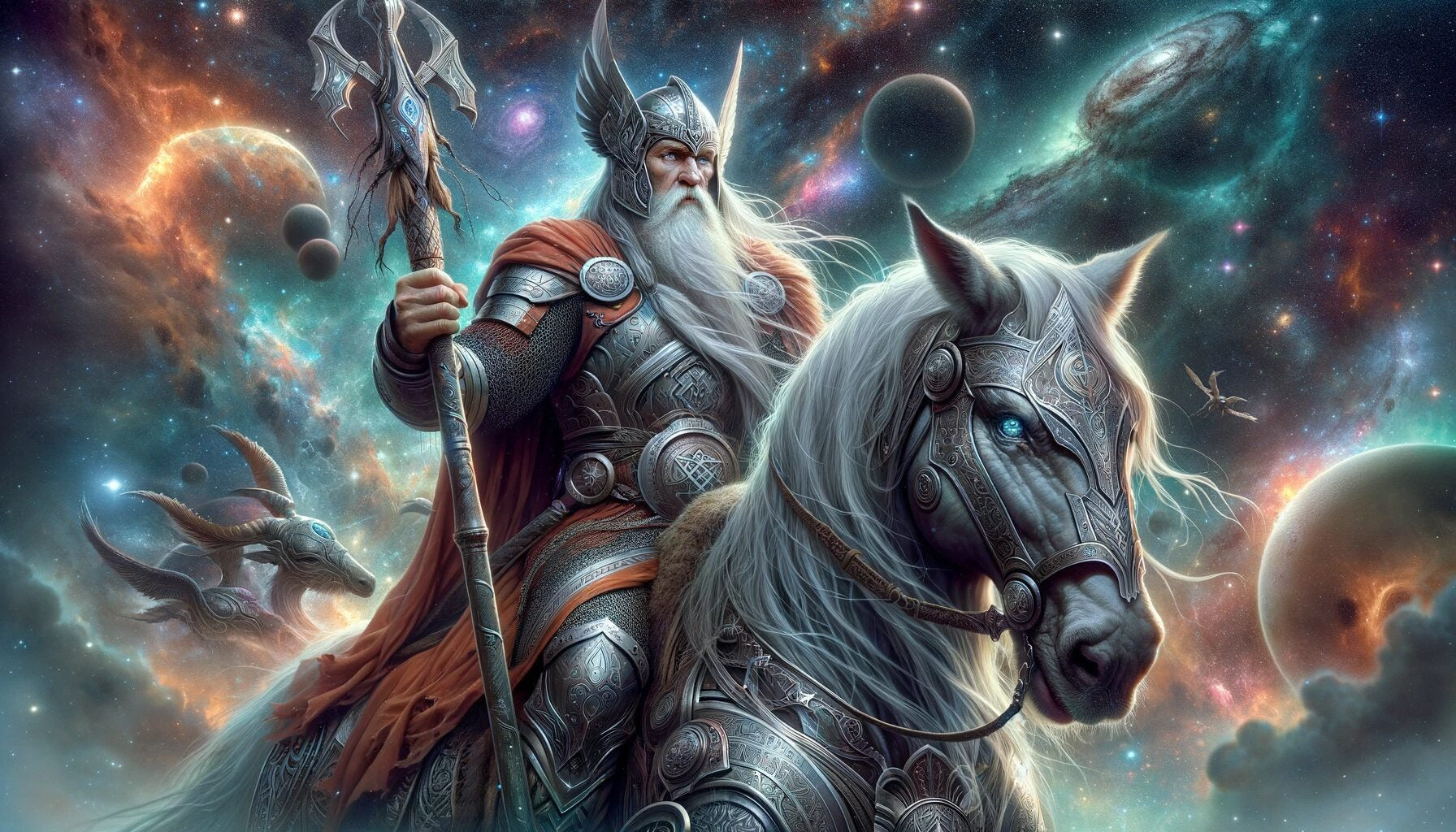Sleipnir: Odin’s Eight-Legged Steed and the Swiftest of All Horses

Sleipnir, the eight-legged horse of Odin, stands as one of the most extraordinary and mysterious creatures in Norse mythology. Known as the swiftest and most powerful of all horses, Sleipnir carries the Allfather, Odin, across the Nine Realms, including the realms of the living and the dead. His origins, abilities, and symbolic meaning make Sleipnir a fascinating figure in the ancient Norse sagas.
The Birth of Sleipnir
Sleipnir’s story begins with the trickster god Loki and a cunning giant. The giant, disguised as a master builder, offered to construct a protective wall around Asgard, the realm of the gods, in exchange for the sun, the moon, and the goddess Freyja. The gods agreed to the deal, thinking the task impossible within the set timeframe. However, the builder used his powerful stallion, Svadilfari, to complete the work at an incredible pace.
Realizing they had been deceived, the gods turned to Loki to prevent the giant from finishing the wall on time. Loki transformed himself into a beautiful mare to lure Svadilfari away from the work. The plan succeeded, and the wall remained incomplete. However, Loki, in mare form, became pregnant by Svadilfari and later gave birth to Sleipnir, an extraordinary eight-legged foal.
Odin, recognizing Sleipnir’s unmatched speed and strength, claimed him as his own steed. From that point on, Sleipnir became Odin’s trusted companion, carrying him across the skies and even into the underworld.
Sleipnir’s Role in Norse Mythology
Sleipnir is most often associated with Odin, the chief of the Aesir gods. As Odin’s steed, Sleipnir has the ability to traverse great distances in an instant, moving between the realms of the gods, humans, and the dead with ease. This makes Sleipnir not just a symbol of speed but also a bridge between worlds, capable of crossing boundaries that others cannot.
One of the most famous tales involving Sleipnir is his journey to the underworld, Helheim. In this story, Odin rides Sleipnir to the land of the dead to seek the wisdom of a deceased seeress. Sleipnir’s ability to carry Odin to Helheim and back demonstrates his role as a conduit between life and death, making him an essential part of Odin’s quests for knowledge.
Symbolism of Sleipnir
Sleipnir’s eight legs are a key aspect of his symbolism. In many cultures, the number eight represents balance, order, and cosmic harmony. Sleipnir’s eight legs can be seen as a symbol of his ability to maintain perfect balance and control, even while traversing the chaotic realms of Norse cosmology.
As Odin’s steed, Sleipnir also symbolizes the pursuit of knowledge and wisdom. Odin is known for his relentless quest for understanding, often going to great lengths to acquire knowledge, including sacrificing his eye and hanging himself on Yggdrasil, the World Tree. Sleipnir, by carrying Odin on these quests, embodies the idea that the journey to wisdom requires speed, strength, and the ability to navigate the unknown.
Additionally, Sleipnir’s unique origin, being the offspring of a stallion and a shape-shifted god, highlights the themes of transformation and duality in Norse mythology. Sleipnir, as a creature born of both divine and bestial elements, represents the blending of different forces to create something truly extraordinary.
Sleipnir in Viking Culture
For the Vikings, horses were highly valued animals, essential for travel, battle, and daily life. Sleipnir, as the greatest of all horses, would have been revered as the ultimate symbol of these qualities. His connection to Odin, the god of war and wisdom, would have made him a figure of admiration and respect among Viking warriors, who sought to emulate the strength and speed that Sleipnir possessed.
In Viking art and artifacts, Sleipnir is sometimes depicted with eight legs, highlighting his unique nature and divine association. These depictions serve as a reminder of the importance of horses in Viking society and the reverence they held for this mystical steed.
Sleipnir in Modern Culture
Sleipnir continues to captivate people today, appearing in various forms of modern media, including literature, movies, and video games. His story is often used to explore themes of transformation, speed, and the pursuit of knowledge. Sleipnir’s image is also popular in modern Norse-inspired art, where he is depicted as a powerful and majestic creature, embodying the enduring legacy of Norse mythology.
In contemporary Heathenry and Asatru practices, Sleipnir is sometimes invoked in rituals related to travel, exploration, and the search for wisdom. He is seen as a guide who can help individuals navigate the complexities of life, much like he does for Odin in the myths.
Conclusion
Sleipnir, the eight-legged horse of Odin, is a symbol of speed, power, and the ability to traverse the boundaries between worlds. His origins, tied to the cunning of Loki and the strength of the giant’s stallion, make him a creature of unique and extraordinary nature. As Odin’s steed, Sleipnir plays a crucial role in the Allfather’s quests for knowledge and wisdom, embodying the qualities of balance, transformation, and cosmic harmony. Whether in ancient Viking culture or modern interpretations, Sleipnir remains a powerful and inspiring figure in the rich tapestry of Norse mythology.
SEO Keywords: Sleipnir, Odin’s horse, Norse mythology, eight-legged horse, Sleipnir symbolism, Viking myths, Loki and Sleipnir, Odin’s steed, Sleipnir in Norse culture, Sleipnir mythology.
